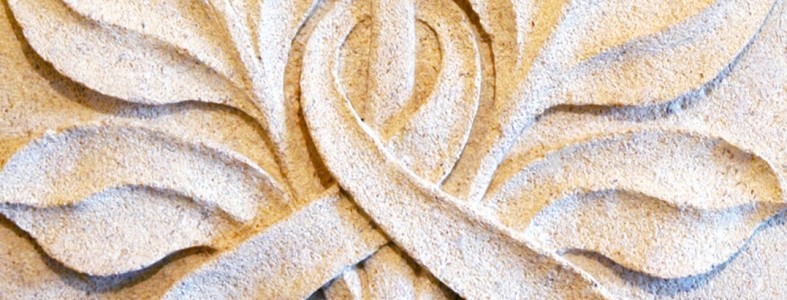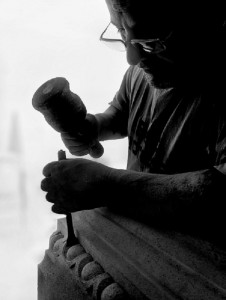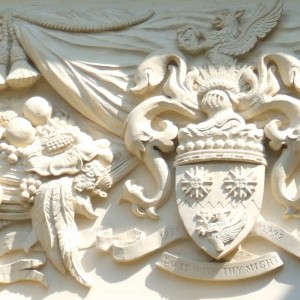
Hand Carved Stone
20 Oct 2014Stone carving is an ancient activity where pieces of rough natural stone are shaped by the controlled removal of stone. Owing to the permanence of the material, stone work has survived which was created during our prehistory.
Work carried out by paleolithic societies to create flint tools is more often referred to as knapping. Stone carving that is done to produce lettering is more often referred to as lettering. The process of removing stone from the earth is called mining or quarrying.
The term Stone carving is one of the processes which may be used by an artist when creating a sculpture. The term also refers to the activity of masons in dressing stone blocks for use in architecture, building or civil engineering. It is also a phrase used by archaeologists, historians, and anthropologists to describe the activity involved in making some types of petroglyphs.
Earliest examples of stone carving are the result of hitting or scratching a softer stone with a harder one, although sometimes more resilient materials such as antlers are known to have been used for relatively soft stone. Another early technique was to use an abrasive that was rubbed on the stone to remove the unwanted area. Prior to the discovery of steel by any culture, all stone carving was carried out by using an abrasion technique, following rough hewing of the stone block using hammers. The reason for this is that bronze, the hardest available metal until steel, is not hard enough to work any but the softest stone. The Ancient Greeks used the ductility of bronze to trap small granules of carborundum, that are naturally occurring on the island of Milos, thus making a very efficient file for abrading the stone.
The development of iron made possible stone carving tools, such as chisels, drills and saws made from steel, that were capable of being hardened and tempered to a state hard enough to cut stone without deforming, while not being so brittle as to shatter. Carving tools have changed little since then.
Modern, industrial, large quantity techniques still rely heavily on abrasion to cut and remove stone, although at a significantly faster rate with processes such as water erosion and diamond saw cutting.
One modern stone carving technique uses a new process: The technique of applying sudden high temperature to the surface. The expansion of the top surface due to the sudden increase in temperature causes it to break away. On a small scale, Oxy-acetylene torches are used. On an industrial scale, lasers are used. On a massive scale, carvings such as the Crazy Horse Memorial carved from the Harney Peak granite of Mount Rushmore and the Confederate Memorial Park in Albany, Georgia are produced using jet heat torches.
Carving stone into sculpture is an activity older than civilization itself, here is one of our stone masons carving additional detail onto a stone fireplace.
The process begins with the selection of a stone for carving. Some artists use the stone itself as inspiration.
The sculptor may begin by forming a model in clay or wax, sketching the form of the statue on paper or drawing a general outline of the statue on the stone itself.
When ready to carve, the artist usually begins by knocking off large portions of unwanted stone. This is the “roughing out” stage of the sculpting process. For this task s/he may select a point chisel, which is a long, hefty piece of steel with a point at one end and a broad striking surface at the other. A pitching tool may also be used at this early stage; which is a wedge-shaped chisel with a broad, flat edge. The pitching tool is useful for splitting the stone and removing large, unwanted chunks. Those two chisels are used in combination with a masons driving hammer.
Once the general shape of the statue has been determined, the sculptor uses other tools to refine the figure. A toothed chisel or claw chisel has multiple gouging surfaces which create parallel lines in the stone. These tools are generally used to add texture to the figure. An artist might mark out specific lines by using calipers to measure an area of stone to be addressed, and marking the removal area with pencil, charcoal or chalk. The stone carver generally uses a shallower stroke at this point in the process, usually in combination with a wooden mallet.
Eventually the sculptor has changed the stone from a rough block into the general shape of the finished statue. Tools called rasps and rifflers are then used to enhance the shape into its final form. A rasp is a flat, steel tool with a coarse surface. The sculptor uses broad, sweeping strokes to remove excess stone as small chips or dust. A riffler is a smaller variation of the rasp, which can be used to create details such as folds of clothing or locks of hair.
The final stage of the carving process is polishing. Sandpaper can be used as a first step in the polishing process, or sand cloth. Emery, a stone that is harder and rougher than the sculpture media, is also used in the finishing process. This abrading, or wearing away, brings out the color of the stone, reveals patterns in the surface and adds a sheen. Tin and iron oxides are often used to give the stone a highly reflective exterior.




